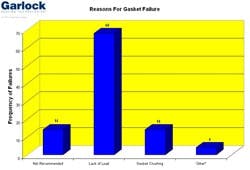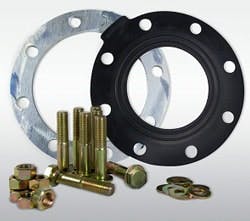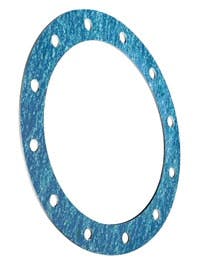Piping is the circulatory system for manufacturing plants, delivering water, steam, compressed air, lubricants and other essential fluids where they’re needed. Piping has a direct effect on sustainability. Today’s piping systems pose challenges that can’t be met with conventional sealing methods.
Most industrial piping systems have numerous flanged joints, each one of which can fail, disrupting plant operations and incurring damage, downtime, lost production and, in some cases, injury and even death. Flanged joints typically fail as a result of insufficient gasket loading. Different types of gaskets seal best at different loads. For example, rubber gaskets seal at loads as low as 100 psi, whereas spiral-wound and metal-jacketed gaskets might require a minimum load of 5,000 psi to seal effectively.
Problems arise when service conditions indicate the use of one type of gasket, but the flange design suggests a different type. Fortunately, there are new gasket materials and configurations that can reconcile these conflicting criteria for more sustainable piping systems.
Industry made great strides in reducing the number of leaks from flanged joints, and some plants have even eliminated them. Because reliable piping system performance, including pumps, valves and other equipment, is critical to plant sustainability both operationally and environmentally, it’s vital to pay careful attention to these flanged joints and the gaskets that keep them from leaking.
Before replacing a leaking gasket, make sure you’ve identified the root cause of the leak. A good place to start is to verify that the proper gasket was installed in the first place based on the operating parameters of the system, notably temperature, media and pressure. The first consideration should be temperature because it can eliminate many unsuitable gasket materials from consideration. Next, look at the media’s chemical compatibility with the gasket, including any secondary media to which the gasket might be exposed, such as fluids that are intermittently present during chemical or steam/hot-water flushing. Then consider pressure. Most systems operate at relatively consistent pressure, but it’s important to take into account severe spikes or surges that might occur.
However, selecting the right gasket requires an understanding of the application that goes beyond these criteria. Flanged joints rarely leak because chemicals attacked the gasket. Most people understand that gasket materials must be compatible with system media. Likewise, it’s rare to find a piping system that exceeds a gasket’s maximum pressure or temperature ratings.
Compressive load key to performance
(Click to enlarge image) Figure 1. The causes of gasket leaks vary, but recent analysis of 100 randomly selected, failed gaskets indicated 68 correlated with insufficient load.
More often than not, flanged joint gasket failures derive from the mechanics of the application, resulting from incorrect compressive load. Eliminating such a simple cause requires knowing the type of flange in which the gasket will be installed, including the material and bolting information, to determine the compressive force. This is extremely important because nearly 70% of gasket failures are attributable to insufficient load (Figure 1).
This root cause might be uneven bolt loads, but it’s far more common that achieving proper loading was impossible given the flange design and available bolting. Under the same bolting scheme, a flat-faced flange with a full-face gasket, for example, won’t apply the same compressive force to the gasket as a raised-face flange with its smaller compressed area. Flange types that produce low compressive gasket loads include flat-faced cast iron flanges commonly found in valves and pumps; flanges on glass-lined equipment; nonmetallic flanges; rolled angle-iron flanges for ductwork; and flanges for vacuum service (Figure 2).
Figure 2. This compressed sheet gasket installed in a flat-faced flange failed because of insufficient compression
The available stress for these types of flanges varies widely. For example, an eight-inch, 150# raised-face flange and a ring gasket having a contact area of 32.2 square inches, a bolt stress of 60,000 psi and a bolt torque of 200 ft.-lbs. produces 4,800 psi of gasket compression. The same size flange with a flat face, fitted with an 80-square-inch, full-face gasket under the same bolt stress and torque, results in gasket stress of only 1,813 psi, about 38% of that from the ring gasket with its smaller contact area.
As a general rule, therefore, the best choice for raised-face flanges are ring gaskets made of compressed sheet, PTFE, graphite or metal. Use full-face rubber gaskets or gaskets with molded-in sealing rings with greatly reduced contact area for flat-face flanges.
Valves and pumps with flat flanges and standard ASME drilling can produce a stress between 1,000 psi and 2,000 psi; glass-lined flanges produce between 2,000 psi and 3,500 psi; flat-faced, non-metallic flanges from 150 psi to 500 psi; and angle-iron flanges around 100 psi to 300 psi. The bolting on some flanges used in vacuum service produces almost no compressive load.
Even within these low-load flanges, there’s considerable variation in available load. Not all nonmetallic flanges are flat faced; many have raised ridges to concentrate the load. Some are stub-end designs in which the contact surface is confined to within the bolt circle and the bolted flange slips on behind the stub-end. These back-up flanges often are metallic and the stub-end design yields a contact area comparable to that of a raised-face flange. These assemblies can generate significantly higher compressive stresses than flat-faced flanges.
Elastomer gaskets might appear to be the obvious solution to low-load flanges. They’re suitable for some flanges types, but compressive loads are typically too high when using glass-lined or stub-end flanges. Moreover, elastomer gaskets aren’t always compatible with system media. PTFE-based gaskets provide chemical compatibility, but require higher loads to seal effectively.
The message is that you should calculate the available compressive stress for a given flange when selecting a gasket or troubleshooting a leak. If the available stress falls between 600 psi and 1,200 psi, a rubber gasket will work. If the calculated stress is below 600 psi, you might need special gaskets to maintain a consistently tight, leak-free seal. By contrast, a stress greater than 1,200 psi might crush and split a rubber gasket, but still might be too low to produce an effective seal with harder materials, such as rubber-bound fiber sheet gaskets or standard PTFE-type materials. These materials work best at stresses of 3,000 psi or more.
Gasketing for low-load flanges
For extremely low-load flanges, consider rubber-based gaskets with molded ridges that concentrate the compressive load. These gaskets often seal where standard rubber sheet gaskets leak. They achieve a tight seal more easily because the ridges contact the flanges first. As more compressive load is applied, larger areas of the flange come in contact with the gasket, preventing it from being crushed, even though the initial contact area is limited.
Figure 3. This gasket’s raised, molded-in rings allow it to seal with 75% less surface contact. The lower seating stress makes it suitable for nonmetallic flanges.
These gaskets can be beefed up with metal backing rings that slip behind the flanges to provide more joint strength. The rings permit greater bolt torque that produces a significantly larger pressure capability. These bolted joints can survive pressures that nearly equal the burst pressures of the piping (Figure 3).
There are many soft, highly compressible PTFE-based gaskets that collapse to 60% to 80% of their original thickness. This, technically, makes these materials softer than some rubber gaskets, but they still require minimum compressive stress to seal the leak paths through the gasket body. Some flange types noted above can produce sufficient compression on these gaskets, but others, especially non-metallic flat-faced flanges, might not consistently seal using these gaskets.
One possible alternative is an elastomer gasket with a PTFE envelope that wraps around the inside diameter and a portion of the gasket face. The envelope can be affixed to the rubber with an adhesive or bonded to the rubber during vulcanization.
Figure 4. This gasket reacts with water or oil to generate its own load, eliminating leaks in low-load applications.
Another solution to a low-load situation is a gasket that swells in the contained liquid (Figure 4). These gaskets typically are of the fiber variety, and are less compressible than rubber gaskets. The advantage of a fiber gasket is that it handles low loads and withstands stresses that would crush a rubber gasket. A secondary advantage is the availability of sheet sizes to 150 in. square, making it possible to use a one-piece gasket in very large flanges.
Another advantage of fiber-based gasket material is its ability to be used with flat-faced flanges when the operating pressure or, in some cases, the test pressure, is too high for a rubber gasket. The higher pressure rating of the fiber gasket allows the joint to function reliably at elevated pressures, while the swelling seals the flat-faced flanges.
Compressive load has an enormous effect on the performance of gasketed joints in industrial piping systems. Available bolt loading is a critical factor in determining the type of gaskets to be used. Many types of gasket material and designs are available to meet the challenges posed by various flange configurations. Keeping your gasket supplier involved in the selection and replacement process will help ensure your plant’s piping systems will perform reliably, efficiently and sustainably.
David Burgess is senior applications engineer for Garlock Sealing Technologies, Palmyra, N.Y. Contact him at [email protected] and (315) 597-4811.




